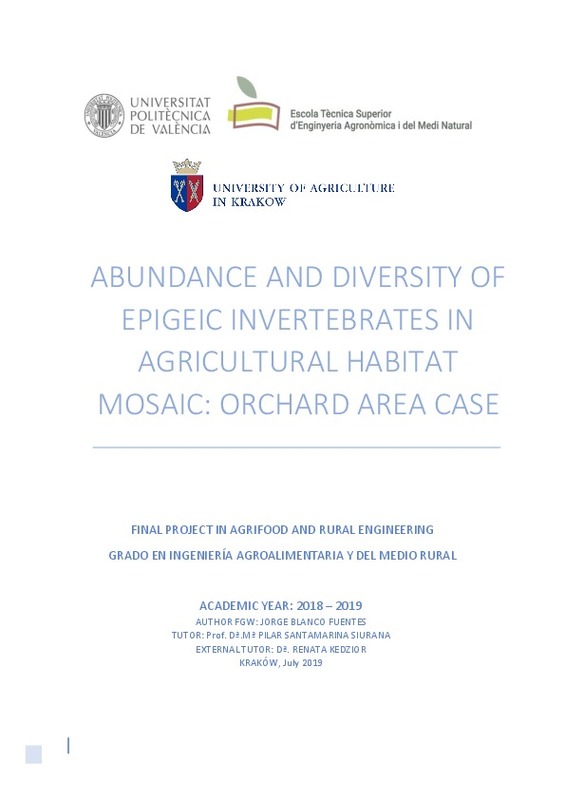|
Resumen:
|
[ES] El presente trabajo está basado en analizar y comparar la abundancia y diversidad de
los invertebrados epigeos de distintos hábitats agrícolas. Además, tratamos de estimar si un
hábitat agricultural heterogéneo ...[+]
[ES] El presente trabajo está basado en analizar y comparar la abundancia y diversidad de
los invertebrados epigeos de distintos hábitats agrícolas. Además, tratamos de estimar si un
hábitat agricultural heterogéneo mejora o empeora la diversidad biológica de la fauna epigea
invertebrada del lugar. La recogida se realizó en la parte sur de Polonia, en una granja frutícola
cerca de Cracovia. La fauna epigea se recolecta mediante el uso de trampas de fallas en cuatro
tipos de hábitat: huerto, pradera, arbusto y bosque. En total se recolectaron 1695 ejemplares
pertenecientes a 11 taxones. Los siguientes grupos fueron identificados en el material
recolectado: Coleoptera, Hymenoptera, Araneae, Mollusca, Diptera, Crustacea, Diplopoda,
Earthworms, Lepidoptera, Dermaptera y Chilopoda. La abundancia media de determinados
taxones de invertebrados fue diversa entre los tipos de hábitat. En el caso de praderas y
huertos, se observó la mayor abundancia de Coleoptera, Hymenoptera, Diptera, Lepidoptera y
Araneae. Por otro lado, Mollusca, Crustacea, Diplopoda y Chilopoda fueron las más
abundantes en arbustos y bosques. Según los parámetros de ensamblajes de Carabid que se
utilizaron como bioindicadores, los resultados mostraron diferencias significativas entre los
tipos de hábitat. Los resultados revelaron que el mosaico heterogéneo de hábitat en el paisaje
agrícola desempeña una función importante en el mantenimiento de una alta diversidad
biológica.
[-]
[EN] The present work is based on analyzing and comparing the abundance and diversity of the
epigeic invertebrates in different agricultural habitats. In addition, the aim of the study was to
estimate if a heterogeneous ...[+]
[EN] The present work is based on analyzing and comparing the abundance and diversity of the
epigeic invertebrates in different agricultural habitats. In addition, the aim of the study was to
estimate if a heterogeneous agricultural habitats improve the biological diversity of the
invertebrate fauna. The survey was conducted in southern part of Poland, in fruit-growing
farm near the Krakow. Epigeic fauna was collected by using pitfall traps in four habitat types:
orchard, meadow, shrub and forest. In total 1695 specimen belonging to 11 taxa were
collected. The following groups were identified in the collected material: Coleoptera,
Hymenoptera, Araneae, Mollusca, Diptera, Crustacea, Diplopoda, Earthworms, Lepidoptera,
Dermaptera and Chilopoda. The mean abundance of particular invertebrate taxa was diverse
among habitat types. In case of meadow and orchard area the highest abundance was noticed
for Coleoptera, Hymenoptera, Diptera, Lepidoptera and Araneae. On the other hand Mollusca,
Crustacea, Diplopoda and Chilopoda were the most abundant in shrub and forest area.
According to Carabid assemblages parameters which was used as bioindicators, the results
showed significant differences among habitat types. The results revealed that heterogenous
mosaic of habitat in agricultural landscape play important function in maintenance of high
biological diversity.
[-]
|







